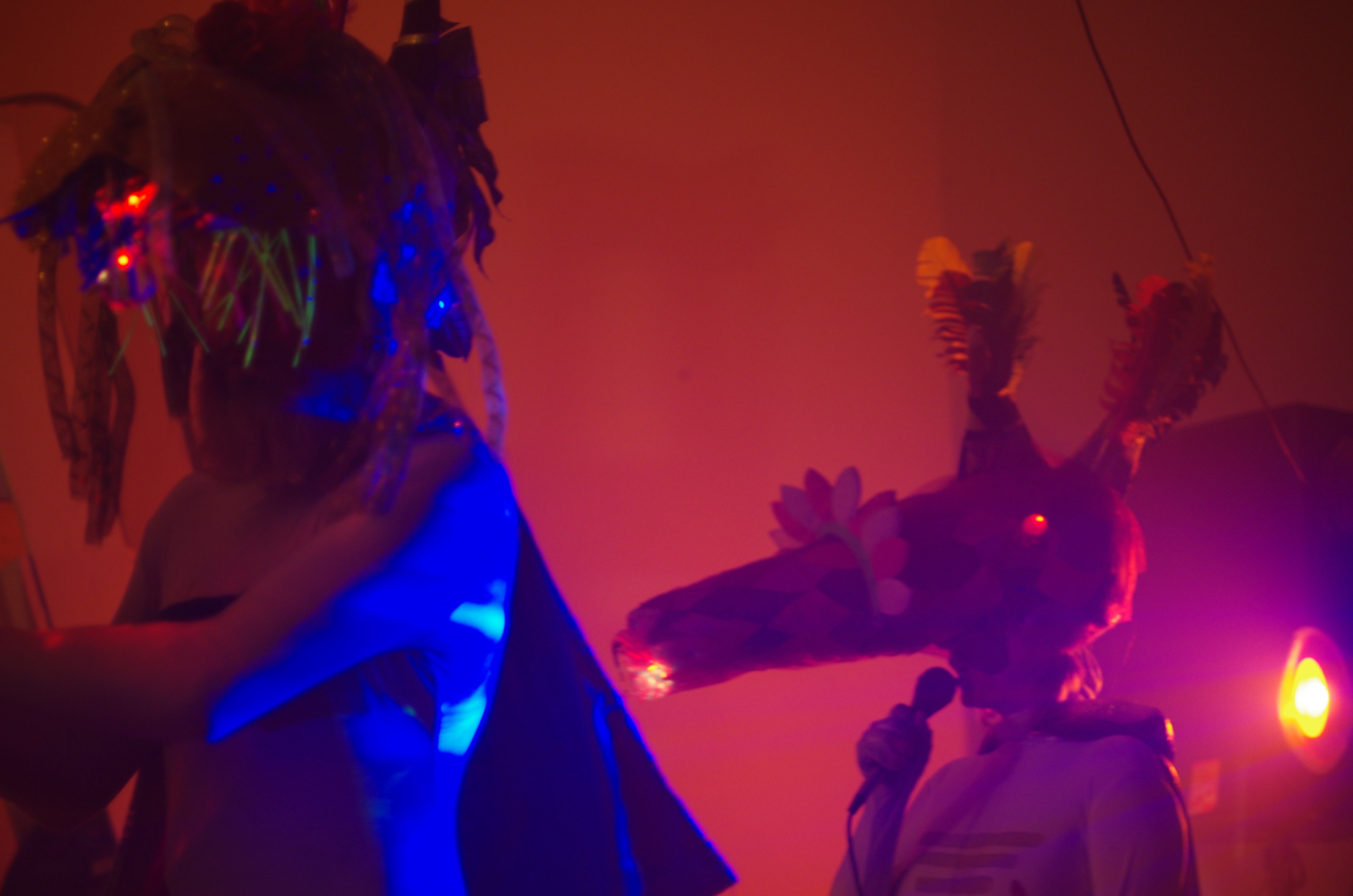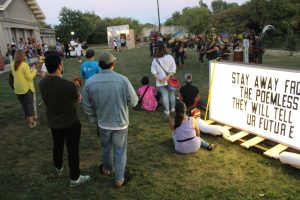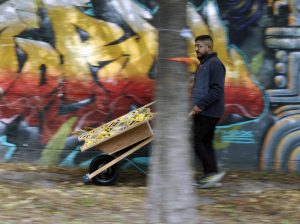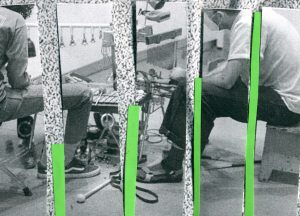La primera vez que visité {\}() {\}∆‡|(){\} fue en 2016, apenas un año después de mi llegada a Chicago. Uno de los profesores en el departamento de performance de la facultad iba a presentar un trabajo en {\}() {\}∆‡|(){\} e invitó a la clase a conocer el espacio y el talento de artistas locales emergentes. Recuerdo el primer impacto; una mezcla de fascinación, asombro, calidez y confort, un sentido absoluto de pertenencia e identificación con el arte, la comunidad y la filosofía del espacio. Procesos experimentales y performances sin terminar, performances con materiales orgánicos, insólitos, arriesgados y dispares como fuego o fluidos corporales, performances desinhibidas, transgresoras, interactivas y viscerales.
The first time I visited {\}() {\}∆‡|(){\} was in 2016, barely a year after my arrival in Chicago. One of my teachers from the performance department was presenting a new work at {\}() {\}∆‡|(){\} and invited our class to discover the space and the talent of emerging local artists. I remember the first impact; a mixture of fascination, wonder, warmth and comfort, an absolute sense of belonging and identification with the art, community and the philosophy of the space. Experimental processes and unfinished performances, performances with organic, unusual, risky and disparate materials such as fire or body fluids, uninhibited, transgressive, interactive and visceral performances.
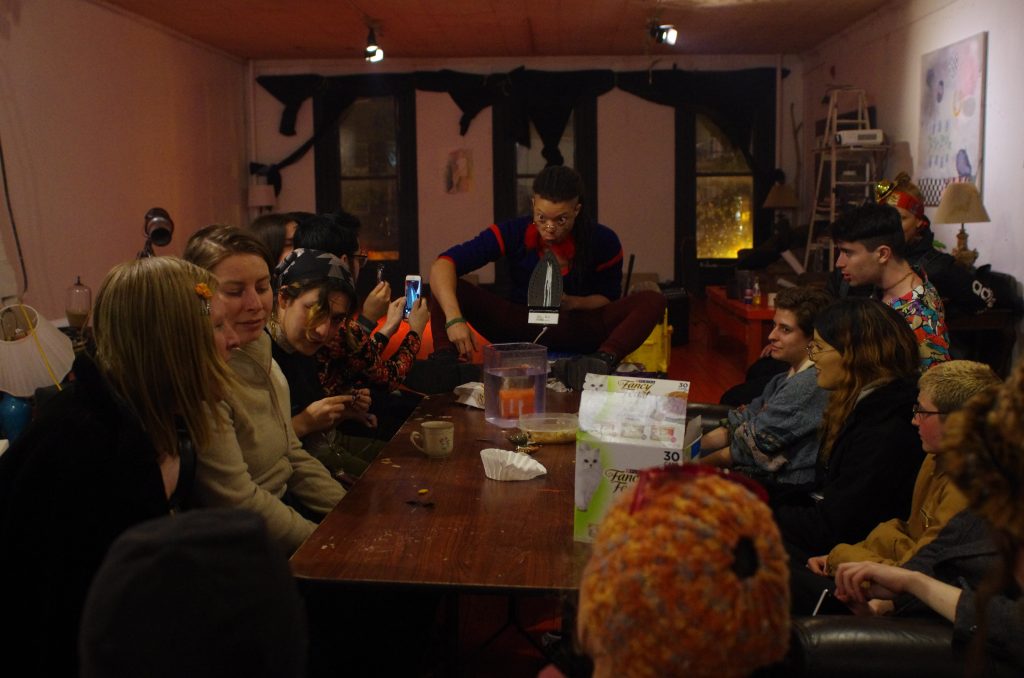
Unos meses más tarde, presentaba mi primera performance en Chicago en {\}() {\}∆‡|(){\}; un espacio que con los años se ha convertido en algo más que una galería; un refugio y espacio comunitario de reunión tanto para mí como para muchos otros artistas extranjeros y locales emergentes que ansiaban formar un vínculo y una comunidad. También llamado {\}() {\}∆‡|(){\} Laboratorio Tangencial de Arte Posnación, es uno de los llespacios multiculturales pioneros que han impulsado y fomentado la creación de una comunidad emergente de performance en Chicago. Instalado en un apartamento tipo loft de unos 600 metros cuadrados en el corazón de Wicker Park, es uno de los pocos espacios artísticos de la década de los setenta que resiste a la gentrificación masiva del barrio, definido tierna y vehementemente por uno de sus fundadores, William Amaya Torres, como “uno de los últimos oasis artísticos independientes y de acción viva y latente en esta puerca y fina zona histórica chicaguense, llena de negocios, tiendas de marcas mundialmente explotadoras, bancos rescatados con nuestros impuestos, bares, turistas enmariguanados a mediodía y borrachos nocturnos armando pelea solos contra los ventanales de la mueblería más prestigiosa, de gusto extraño y hardcorera de la zona!!”
A few months later, I presented my first performance in Chicago at {\}() {\}∆‡|(){\}; a space that over the years has become more than a gallery; a refuge and community gathering space for me and for many other foreign and local emerging artists who were craving to form a bond and a community. {\}() {\}∆‡|(){\} is one of the pioneer multicultural spaces that has driven and encouraged the creation of an emerging performance community in Chicago. Installed in a loft style apartment of about 600 square meters in the heart of Wicker Park, it is one of the few artistic spaces from the seventies that still thrive through the massive gentrification of the neighborhood, tender and vehemently defined by one of its founders, William Amaya Torres, as “one of the last independent artistic oasis with life and beating action in this fancy and filthy, Chicagoan, Damen Blue line stop, historic zone, filled with businesses, stores with globally exploitative brands, banks bailed out with our taxes, 5am bars, strolling marihuanized tourists at noon and late night drunkards picking fights with themselves against the windows of the most prestigious, strange taste and hardcore furniture store of the zone.”
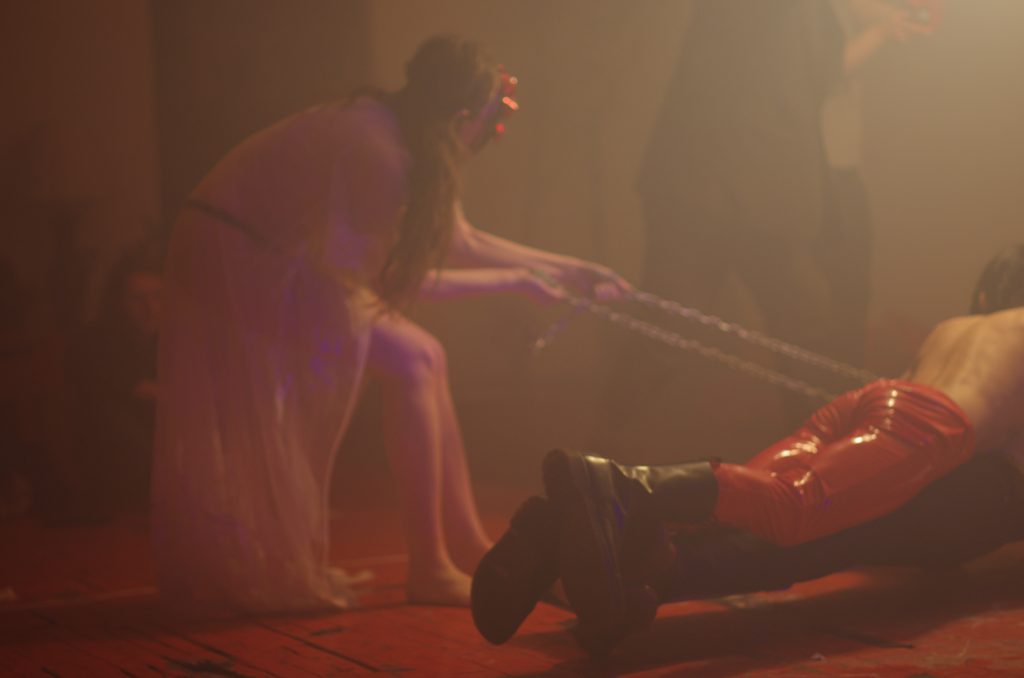
Marina Cortes Calle: Como y por qué surgió No Nation? Cómo ha evolucionado desde su inicio?
William Amaya Torres: En el verano del 12010 E.H. (Era Humana) me mudé a donde unos amigos que vivían en un apartamento tipo loft en un segundo piso, donde hacían conciertos y fiestas. Al lugar le llamaban Happy Dog Gallery. Al año y medio de estar en Happy Dog l∞s muchach∞s con los que me había mudado terminaron sus estudios en la universidad y se mudaron a otros países o estados. Heredé el espacio como hogar y galería, y para poder desarrollar y vivir entre arte, réinventé el espacio como {\}() {\}∆‡|(){\}. El nombre lo sacamos con un amigo llamado Snorre Sjønøst Henriksen.
En simples palabras, mmmmmmmm… el lugar te habla y te dice, “oye dame vida, comparte la vida, y yo te doy un poco también”. Es un ciclo de inspiración que se hace posible porque la sala del lugar es un rectángulo de 50×25 pies. También se hace posible porque el dueño del edificio me deja arreglar las cosas a mi manera, por ejemplo cuando me mudé, el piso, que es de madera estaba super sucio, más sucio que el piso de la calle. Un día lo limpié bien bonito y lo pinté de rojo con la ayuda de vari@s amig∞s y Ryan. Yo creo que he repintado y construído cosas en todo el lugar. He tomado la situación como una instalación viviente, una forma de expresión que inhala y exhala el arte. Eso me digo a mí mismo como para pensar que la vida en el exilio tiene algo de sentido, y pues lo ha tenido.
Con ese espíritu e intención {\}() {\}∆‡|(){\} se ha mantenido y crecido como un lugar autogestionado para compartir y experimentar con ideas que se convierten en arte. El enfoque, yo diría que ha sido más que todo en Arte Acción o Performance Art. En el año 12014 de la era humana, el brillante y pillo Ryan Greenlee se unió al cuento y se convirtió en el fotógrafo oficial y codirector de la movida. Hace 2 años Ryan inició un proyecto en serie llamado “Smudge Cinema”, el cual consiste en proyectar una película una vez a la semana e invitar amig∞s a verla y luego armar tertulia.
Marina Cortes Calle: How and why did No Nation arise? How has it evolved since its inception?
William Amaya Torres: In the summer of 12010 E.H. (Human Era) I moved into a loft apartment on the second floor, where some friends lived, played concerts, did shows and parties, it was called Happy Dog Gallery. Within a year and a half of being in Happy Dog, the friends with whom I had moved finished their studies at the university and moved to other countries or states. I inherited the space as home and gallery, and in order to develop and live among art, reinvented the space as {\} () {\} ∆ ‡ | () {\}. We got the name with a friend named Snorre Sjønøst Henriksen.
The place speaks to you and tells you, “hey give me life, share life and I give you a little too.” It is a cycle of inspiration that is made possible because the room of the place is a rectangle of 50×25 feet, it is also possible because the owner of the building lets me take care and fix things my way, for example when I moved, the wooden floor, was super dirty, dirtier than the street floor. One day I cleaned it very nicely and painted it bright red with the help of a few friends and Ryan. I think I have repainted and built things all over the place. I have taken the situation/space as a living installation that inhales and exhales art. I tell myself that to think that life in exile makes some sense, and it has.
With that spirit and intention {\} () {\} ∆ ‡ | () {\} has been maintained, and has grown as a self-managed place to share and experiment with ideas that become art. The approach I would say has been more than anything in Action Art or Performance Art. In the year 12014 of the human era, the brilliant Ryan Greenlee joined the story and became the official photographer and co-director of la movida 2 years ago he started a series project called “Smudge Cinema”, which consists of projecting a movie once a week and inviting friends to see it and then discuss it.
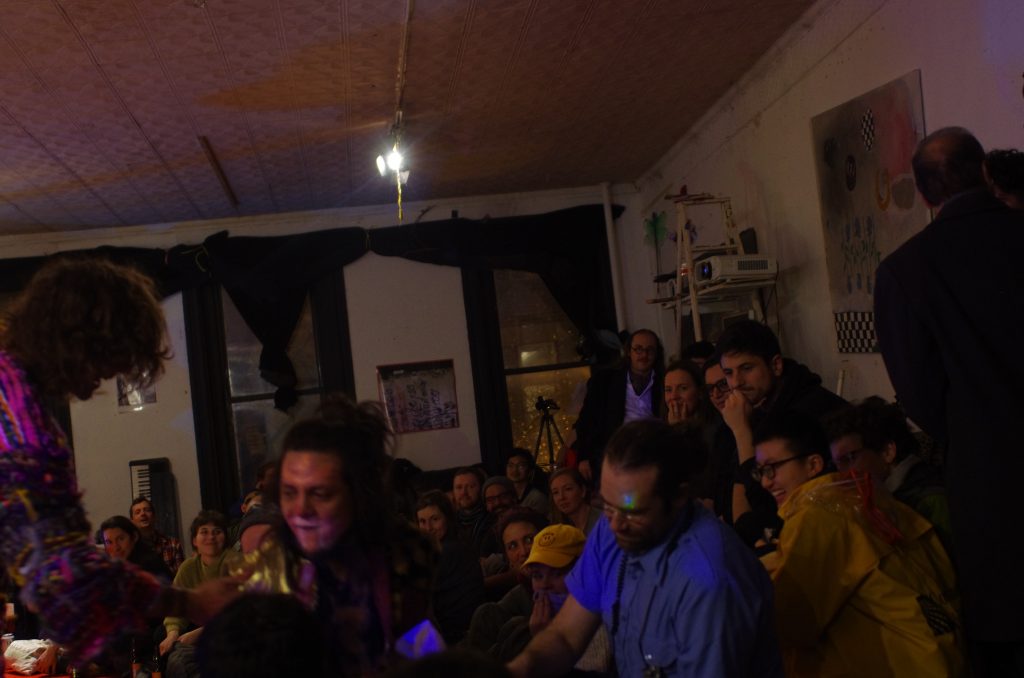
También podría decirse que {\}() {\}∆‡|(){\} es un espacio de arte interdisciplinario y de intercambio radical en el corazón de Wicker Park en Chicago-Esclavos (des)Unidos de Amnesia, en el cual hemos creado y colaborado en performances, proyecciones y grabaciones cinematográficas, palestras, grupos de lectura y talleres entre otras cosas. La entrada no es gratuita. Le pedimos a los visitantes que paguen con un poema o una impresión de su trasero. Contamos con una estación especial para ambas cosas. Mi armario es la estación de impresión de traseros, usamos témpera a base de agua de alto pigmento que no es tóxica y tampoco contiene plomo. En ocasiones hay personas que quieren pagar con dinero, yo les digo que si tienen ganas de eso que simplemente lo escondan por ahí. No rechazamos a nadie por falta de medios económicos.
Estamos situados en la 1542 N. Milwaukee Avenue en el segundo y actualmente también en el cuarto piso, lo acabamos de adquirir. El plan es expandir un programa de residencia artística que fundé en {\}() {\}∆‡|(){\} hace unos 4 años. Se llama {\}() {\}∆‡|(){\} Deschool. La idea es que se postulen artistas con proyectos que quieran desarrollar entre 3 y 6 meses. Los artistas en residencia presentan trabajo al menos 3 veces durante su estadía, pueden vincularse al proceso de curaduría y tener más exhibiciones si quieren. Al final de la residencia armo un plan para tener una exhibición internacional, hemos presentado varias veces en Sudamérica. Este año fuimos 2 veces a Bogotá, la primera con la residencia y la segunda con artistas invitados a un festival internacional performance del el cual fui co-curador y organizador.
No tenemos financiamiento de terceros, así que la residencia artística tiene precio en dinero para los artistas que la quieran tomar. Lo considero un buen trato. Y en términos comparativos con otras residencias artísticas en Chicago. La verdad no conozco ninguna otra que ofrezca estadía y espacio para trabajar y exponer por 3 o 6 meses. Si estás interesadx, envíanos tu portafolio y propuesta de trabajo.
MC: ¿Cuál es la misión y filosofía del espacio?
WA: {\} () {\} ∆ ‡ | () {\} Tangential Unspace Art Lab, es una desorganización independiente cuyo nombre proviene de tomar conciencia crítica, activa e inquisitiva sobre la relación entre origen, identidad y nación. ¿Qué es la nación para nosotros? Son líneas arbitrarias en el planeta, trazadas mediante guerras, que en la historia se han usado para referenciar, señalar o revelar la proveniencia geográfica, origen o identidad de las personas. ¿Qué es una persona para nosotros? Una persona es un ser el cual es una entidad que a su vez es un evento en desarrollo e interacción viva. Cuando se tiene en cuenta que el origen es la esencia fundamental de un ser o cosa, “la nación” se convierte en un instrumento limitado y obsoleto incapaz de describir el origen o la identidad de la persona, ya que su historia de arbitrariedad y violencia, por definición borran el camino que conducía a la descripción de la complejidad del ser. El origen arbitrario y violento de la “nación” la lleva a convertirse en un implante social que trae más preconcepciones que revelaciones. Por esto rechazamos la nación y el nacionalismo como referencia de origen o identidad. Primer paso hacia {\}() {\}∆‡|(){\}, segundo paso a posnación, tercer paso, bienvenid∞s a un deslugar de cuestionamiento accessible.
{\} () {\} ∆ ‡ | () {\} tiene que ver con la realidad, cuando lo que marca esta es un estado de condición o condiciones. ¿Como se cambia la realidad? Se cambia a través de ejercicios y/o acciones; de arte y performance art en nuestro caso. Somos conscientes que nuestras acciones están vivas y que nuestros ejercicios artísticos forman parte de la realidad y la alteran, cambiando sus condiciones, fluyen en su constancia hacia donde las imaginemos. Puede que la gratificación inmediata no sea nuestro plato favorito, le apuntamos al aprendizaje internalizado a través del subconsciente, activando nuestra conciencia en grupo, dando un paso juntos hacia lo desconocido, iniciando por la duración del evento en curso, la performance es/as/como, eso…
It could also be said that {\} () {\} ∆ ‡ | () {\} is a space of interdisciplinary art and radical exchange in the heart of Wicker Park in Chicago-United Slaves of Amnesia, in which we have created and collaborated in performances, projections and film/video shoots, lectures, reading groups and workshops among other things. Admission is not free, we ask visitors to pay with a poem or a butt print. We have a special station for both. My closet is the butt print station. We use high pigment water based tempera that is not toxic and does not contain lead. Sometimes there are people who want to pay with money, I tell them that if they feel like it, to just hide it somewhere. We do not turn people away for lack of financial means.
We are located at 1542 N. Milwaukee Avenue on the second floor and currently also on the fourth floor. We just acquired it. The plan is to expand an Artist in Residence program that I founded about 4 years ago. It’s called {\} () {\} ∆ ‡ | () {\} Deschool. The idea is to host/house artists that want to develop projects for 3 or 6 months. Artists in residence have to present work at least 3 times during their stay. They can be linked to the curatorial process and have more exhibitions if they want. At the end of the residence I put together a plan to have an international exhibition. We have already presented several times in South America. This year we went to Bogotá twice, the first with the residence and the second to an international performance festival for which I was co-curator and organizer.
We don’t have fiscal sponsorship, so the artistic residence has a cost for artists who want to take it. I consider it a good deal because in comparative terms with other artistic residences in Chicago, I really don’t know of any other one that offers 3 or 6 months live/work/exhibition space. If you are interested, send us your portfolio and work proposal.
MC : What is the philosophy and mission of the space?
WA : {\} () {\} ∆ ‡ | () {\} Tangential Unspace Art Lab, is an independent disorganization whose name comes from taking critical, active and inquiring awareness about the relationship between origin, identity and nation. What is the nation for us? They are arbitrary lines on the planet, drawn through wars, which in history have been used to reference, indicate or reveal the geographical origin, identity and/or identity of people. What is a person for us? A person is a being which is an entity that in turn is an event in live development and interaction. When one considers that the origin is the fundamental essence of a being or thing, “the nation” becomes a limited and obsolete instrument that cannot describe either the origin or identity of the person because its history of arbitrariness and violence, by definition, erases the path that leads to the description of the complexity of being. The arbitrary and violent origin of the “nation” leads it to become a social implant that brings more preconceptions than revelations. Therefore we reject the nation and nationalism as a reference of origin and Identity.
First step towards {\} () {\} ∆ ‡ | () {\}, second step to posnación, third step, welcome to an unplace of accessible questioning. {\} () {\} ∆ ‡ | () {\} has to do with reality, when what marks it is a state of condition or conditions. How does reality change? It is changed through exercises and / or actions; of art and performance art in our case. We are aware that our actions are alive and that our artistic exercises are part of reality and alter it, changing its conditions, flowing in their constancy to where we imagine them. Immediate gratification may not be our favorite dish, we aim at internalized learning through the subconscious, activating our group conscience, taking a step together towards the unknown starting from the duration of the current event, the performance is / as / how, like that..
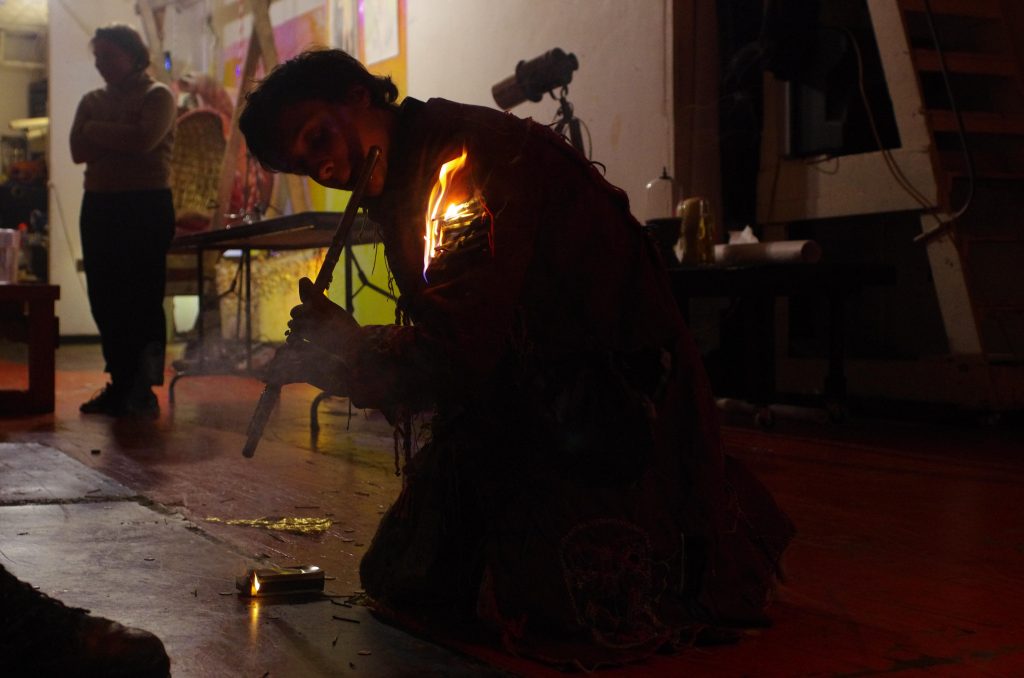
Si tienes trabajo que quieras mostrar, escríbenos, estamos abiertos. nonationartlab@gmail.com
Las reglas del espacio son:
1- No mates a nadie en el espacio
2- No nos hagas cómplices de una violencia contra otra persona o tu suicidio en el espacio.
3- No le prendas fuego a la casa
4- No inundes la casa
Nuestros objetivos son continuar ofreciendo apoyo a artistas libres de coste, continuar creando conexiones, aproximarnos a espacios herman∞s para así enriquecer y evolucionar juntos, conseguir los medios necesarios para vivir una vida decente sin tener que preocuparnos demasiado por los gastos del mes siguiente. Nuestro sueño es participar en la creación de un diálogo amigable, rudo pero amable, e inteligente para así vomitar y sudar de las tripas y entrañas de la mente y del alma creando una sociedad de amor e inspiración infinita que trascienda los implantes sociales.
N a t i o n s a r e a r b i t r a r y d e l i n e a t i o n s i n g e o g r a p h y t h a t t h r o u g h h i s t o r y h a v e k e p t o r / a n d e x p a n d e d t h e i r b o r d e r s b y m a k i n g w a r s a g a i n s t e a c h o t h e r …N a t i o n a l i t y i s a s o c i a l i m p l a n t a n d a n o b s o l e t e p r i m a r y r e f e r e n t t o i d e n t i t y.
MC: ¿Alguna anécdota o experiencia notable que te emocionó o impresionó?
WA: El día que los veteranos de guerra del ejército estadounidense hicieron un taller y mostraron cómo iban a botar sus medallas en forma de protesta y rechazo contra las guerras que NATO y Estados Unidos armaron en Irak y Afganistán. Esto sucedió al día siguiente.
MC:¿Cómo se financia No Nation y cuáles son las dificultades de mantener un espacio autogestionado?
WA:La moneda de no nation son poemas e impresiones de traseros. Esto es un suicidio comercial y probablemente cualquier idea de negocio sostenible que un medio experto te quiera dar será mejor. Es una experiencia finita y lo que se tiene, y/o es, existe mientras, cuándo y durante. Deudas y deudas que a punta de salario mínimo le tomarían varias vidas a este mutante desnacional para pagar. No nation se mantiene a flote con una combinación de cosas: Programa de residencia artística, trabajos varios, planes de pago con el gas y la luz..
MC:¿Cuáles son algunos proyectos presentes y futuros que estéis planeando?
WA:Los proyectos vienen constantemente, puede que un fin de semana salgamos a ver alguna exhibición y conozcamos a un∞ o un grupo de artistas que quieren compartir su trabajo, entonces ahí la armamos. A veces también se planea con un poco más de anticipación, o artistas nos contactan para que los incluyamos, colaboremos, o por que quieren que les prestemos el espacio.
If you have work that you want to show, write to us, we are open. nonationartlab@gmail.com
The rules of space are:
1-Do not kill anyone in the space
2-Do not make us complicit in a violent act against another person or your suicide in the space.
3-Do not set fire to the house
4- Do not flood the house
Our objectives are to continue offering a space that supports art and artists free of charge, to continue creating connections, to approach sibling spaces, enriching and thus evolving together and getting the necessary means to live a decent life without having to worry too much about the expenses of the next month. Our dream is to participate in the creation of a friendly, relentless but kind, and intelligent dialogue, to vomit and sweat from the guts and innards of the mind and soul a society of love and infinite inspiration that critically pierces, breaks and transcends social implants of thought.
N a t i o n s a r e a r b i t r a r y d e l i n e a t i o n s i n g e o g r a p h y t h a t t h r o u g h h i s t o r y h a v e k e p t o r / a n d e x p a n d e d t h e i r b o r d e r s b y m a k i n g w a r s a g a i n s t e a c h o t h e r ,,,N a t i o n a l i t y i s a s o c i a l i m p l a n t a n d a n o b s o l e t e p r i m a r y r e f e r e n t t o i d e n t i t y.
MC: Any anecdote or remarkable experience that moved or impressed you?
WA: One day we opened the space to U.S.A. army war veterans who were workshopping on how to protest and not get arrested. They were the ones that threw medals in rejection to the wars that NATO and the United States started in Iraq and Afghanistan. They did it the next day.
MC: How is No Nation funded and what are the difficulties of maintaining a DIY/independent space?
WA: The currency of no nation are poems and butt prints. This is a commercial suicide and probably any idea of sustainable business that a semi expert wants to give you will be better. It is a finite experience and what you have, and / or, is, exists while, when and during. Debts and debts that at the point of minimum wage might take many lives for this denational mutant to pay. No nation also stays afloat with a combination of things: The artist residency program, various jobs and debts and payment plans with gas and electricity.
MC: What are some present and future projects you are planning?
WA: Projects are constantly coming. Maybe this week we go out to see a show and meet an artist or group of artists who want to share their work, so we put it together. Sometimes it is also planned with a little more anticipation or we get contacted to participate, collaborate or host.
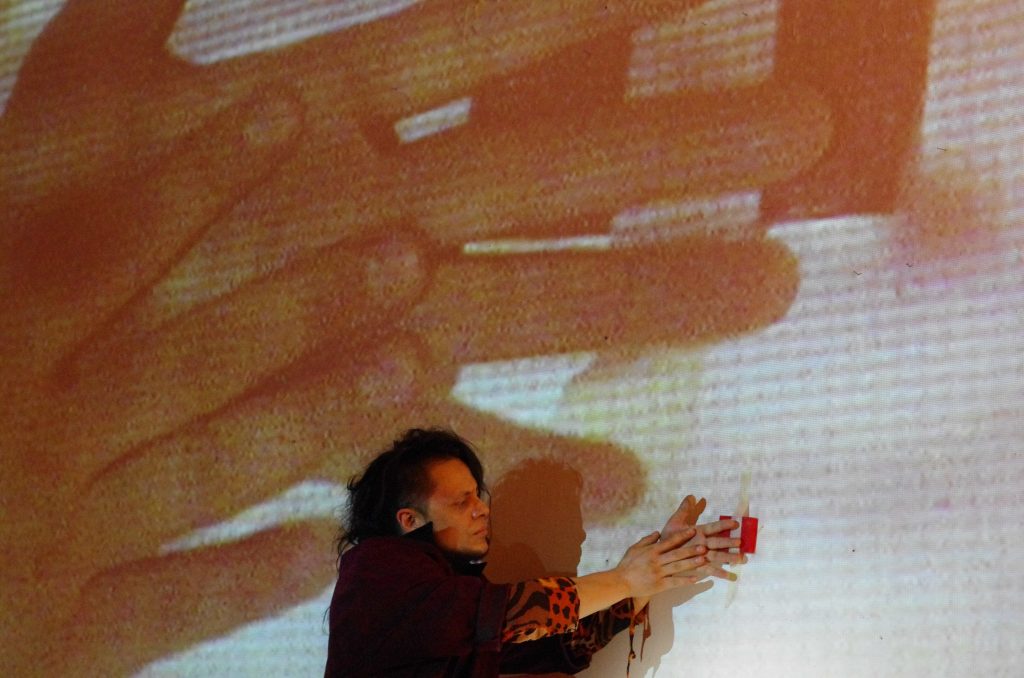
También estamos planeando ir de vuelta a colombia en abril del 12020 E.H. para mostrar y trabajar conjuntamente con nuestros amig∞s performer∞s y artistas de ACCIONARAR, el festival de performance EAVD y LAVAMOATUMBA entre otr@s, tenemos una invitación para ir a Brasil a participar y armar un festival de performance el otro año, vamos a ver que sucede.
MC:¿Cómo te imaginas el futuro de No Nation?
WA: Como una acción inter/extranacional, brotando en las calles y centros del mundo, haciendo intervenciones de performance a través de la realidad viviente.
We are also planning to go back to Colombia in April of 12020 to perform and work again with our artist friends from ACCIONARAR, the EAVD Performance Art festival and LAVAMOTUMBA amongst others. We also have a pending invitation to go to Brazil and make and participate in a festival, we will see what happens.
MC: How do you imagine the future of No Nation?
WA: As an Inter/extranational happening in the streets and centers of different countries, making performance interventions through living reality.
Featured Image: Two figures wearing elaborate papier mache headpieces perform in a dimly lit room. The person in the foreground seems to be in motion with an arm raised in front, and the person in the background wears a mask with a long snout and holds a microphone to their mouth. Image courtesy of {\}(){\}∆‡|(){\}.

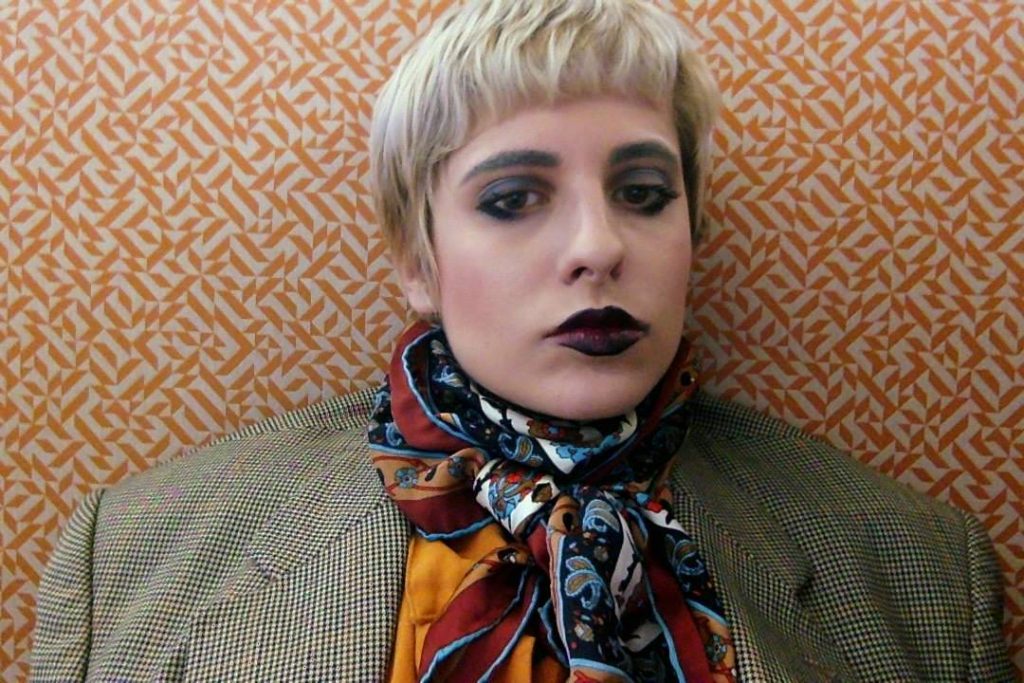
Marina Cortes Calle is a Chicago-based interdisciplinary artist with a focus on performance, film and curatorial practice attending the School of the Art Institute of Chicago. Originally born in Spain and raised in Brazil, her work is deeply inspired by social practice, community-oriented work, and institutional critique. She has performed at different venues in Chicago (No Nation, Outer Space, Sullivan Galleries, Defibrillator, Flat Iron, Links Hall, The University of Chicago, Chicago Cultural Center) and internationally, (Casa da Luz and Phd Galeria in Sao Paulo and SomoS Art in Berlin).
